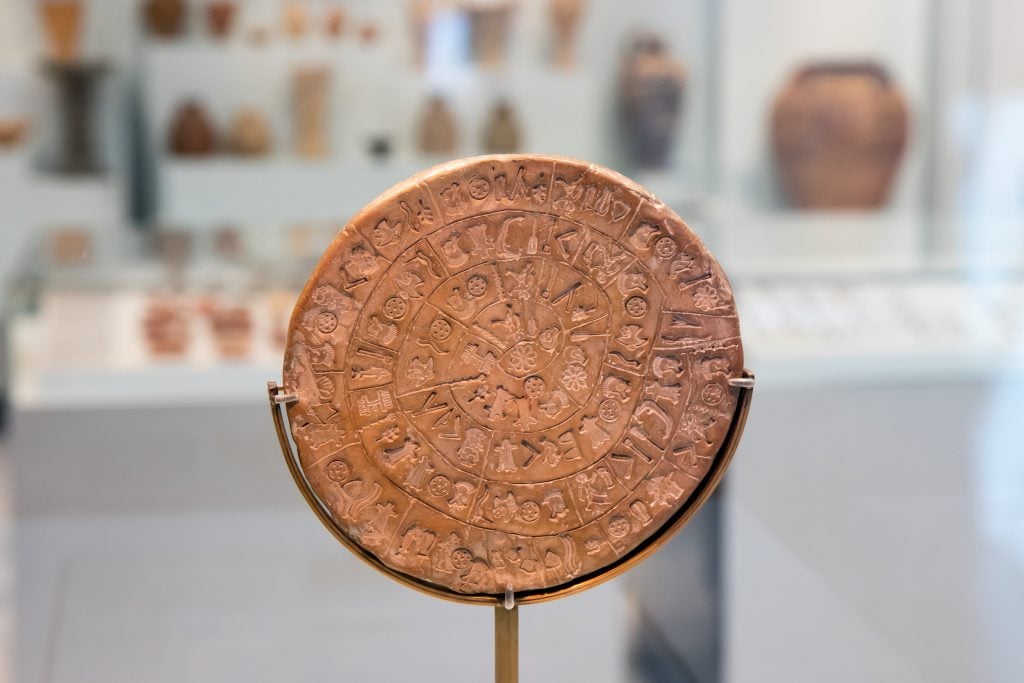
25 Dec The Ancient Cretan Puzzle That’s Left Historians Scratching Their Heads
Source Credit: Content and images from Artnet News. Read the original article - https://news.artnet.com/art-world/the-hunt-phaistos-disk-2564109
On a summer day in 1908, Italian archaeologist Luigi Pernier unearthed what would become one of history’s most tantalizing puzzles. While excavating the ancient Minoan palace of Phaistos in Crete, Pernier came across a peculiar artifact: a clay disk roughly the size of a dinner plate, covered on both sides with a spiral of stamped symbols unlike any other ancient writing system known.
The object would come to be known as the Phaistos Disk. Since its discovery over a century ago, it has been something of an obsession for many scholars. Nobody really knows who made it or if we’re even holding it right-side up, let alone what language it’s in.
What makes the Phaistos Disk particularly mind-bending is its method of creation. Each of its 241 symbols was carefully pressed into the soft clay using individual stamps. The 45 different signs spiral inward from the disk’s edge on both sides, arranged in tidy little groups that closely—and tantalizingly—resemble words. The symbols themselves are a parade of miniature artworks: strutting figures wearing feathered headdresses, fish swimming nowhere, birds frozen in flight, along with tools, plants, and buildings rendered in remarkable detail.

A close-up of the Phaistos Disk reveals its as-yet undeciphered symbols arranged in a spiral on both sides from the palace of Phaistos, Crete. (National Archaeological Museum) (Photo by DeAgostini/Getty Images)
When it was first discovered, the archaeological world was skeptical about its Cretan origins. The renowned Arthur Evans (the same archaeologist who excavated the Cretan city of Knossos) pointed out that these dapper little figures didn’t dress like typical Minoans, and the symbols looked nothing like known Cretan writing. Some scholars went so far as to suggest it might be an elaborate hoax.
The question of who created this ancient riddler has sparked nearly as much debate as its meaning. Some scholars suggest it came from seafaring traders, perhaps Luwians from Anatolia (modern-day Turkey) who might have brought their own writing system to Crete’s shores.
Others point to the Minoan civilization itself, arguing that the disk represents a unique moment of innovation in Cretan history. Over the years, pieces of pottery and other artifacts emerged from Cretan soil bearing identical symbols to those on the disk, putting the hoax theory to bed. A gold ring found at Knossos even showed a similar spiral inscription pattern, suggesting that maybe the spiral writing was more common in ancient Crete than previously thought.

The Phaistos Disk on view at the Heraklion Archaeological Museum. Photo: Shutterstock.
As for what the disk actually says, no one really knows. Scholars, some who have dedicated decades of their lives to deciphering the disk, have suggested everything from a prayer to an adventure story, from military propaganda to instructions for a board game. Some regard it as a sacred text, others as an ancient geometric theorem. It’s like having one of the world’s oldest storybooks, but no way to read it, and without more examples of this mysterious writing system, the code might never be cracked.
The true marvel of the Phaistos Disk is the sophistication of its creation. Manufacturing individual stamps for printing would have required remarkable technological skill and forethought. Whether its creator was inspired by Egyptian hieroglyphs, Anatolian scripts, or simply had a brilliant original idea, remains hotly debated.
Today, this ancient mystery resides in Crete’s Heraklion Archaeological Museum, still withholding its secrets after more than 3,000 years. While we may never decipher its message, the Phaistos Disk stands as an emblem of ancient Mediterranean civilizations’ complexity, and a reminder that some of history’s best stories are the ones we can’t even read… yet.
The Hunt explores art and ancient relics that are—alas!—lost to time. From the Ark of the Covenant to Cleopatra’s tomb, these legendary treasures have long captured the imaginations of historians and archaeologists, even if they remain buried under layers of sand, stone, and history.
Source Credit: Content and images from Artnet News. Read the original article - https://news.artnet.com/art-world/the-hunt-phaistos-disk-2564109

